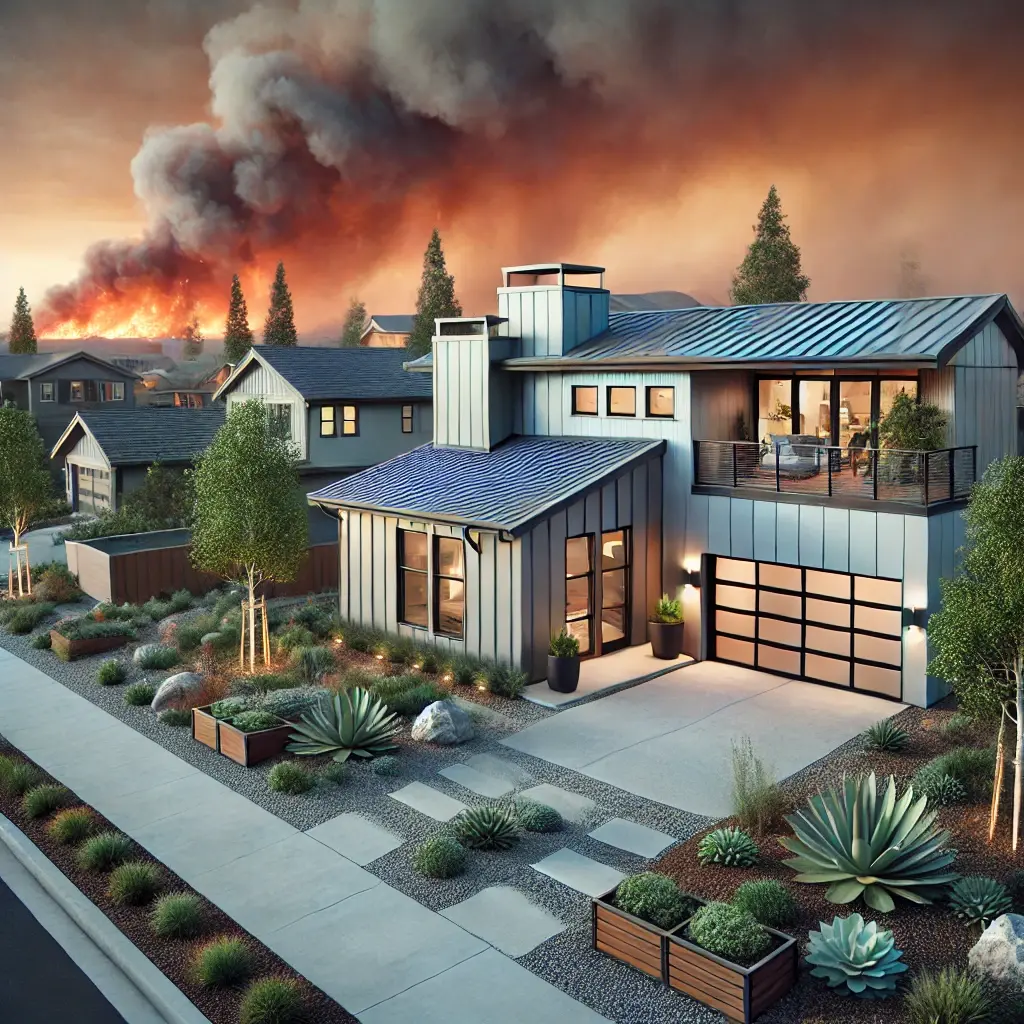Unbreakable Homes: How Fire-Resistant Houses Are Changing the Future of Homeownership
Read Time 7 mins | Written by: Henge Team

Wildfires are no longer rare, seasonal events. They are becoming a year-round reality, destroying thousands of homes annually. In the U.S. alone, wildfires burned over 2.5 million acres in 2023, leaving entire towns in ashes.
Yet, in the aftermath of every major fire, some homes remain untouched—while everything around them is reduced to rubble.
What makes these homes different?
It’s not luck. It’s fireproof design, smart materials, and intentional planning.
The Rising Threat of Wildfires and Why Traditional Homes Fail
Wildfires are burning hotter and spreading faster than ever before. Several factors contribute to this:
- Higher Temperatures: Rising global temperatures are making forests drier and more flammable.
- Increased Winds: Stronger winds spread embers miles ahead of the actual fire.
- Longer Fire Seasons: Wildfires are no longer seasonal but a constant threat in many regions.
- Urban Sprawl into Fire Zones: More homes are being built in fire-prone areas without proper fire-resistant designs.
Traditional homes are vulnerable because they are often constructed with flammable materials like wood siding, asphalt shingles, and exposed eaves that allow embers to ignite the structure. Once a home catches fire, it is nearly impossible to save.
The good news? Some homeowners are taking proactive steps to protect their properties, and platforms like Henge are making it easier to access insurance and property resilience tools for wildfire-prone areas.
How Fireproof Homes Are Designed to Survive
The key to a fireproof home is building with materials and design choices that prevent ignition, resist high heat, and eliminate weak points where embers can enter.
Fire-Resistant Building Materials
- Concrete and GigaCrete: Unlike wood-framed houses, homes built with concrete or GigaCrete do not burn.
- Metal and Clay Tile Roofs: Traditional asphalt shingles ignite easily, while metal and tile roofs resist embers and extreme heat.
- Fire-Rated Glass Windows: Dual-pane, tempered glass windows are less likely to break from heat exposure, preventing embers from entering.
- Fiber Cement or Brick Siding: Instead of wood siding, fiber cement boards and brick offer much higher resistance to ignition.
For homeowners in wildfire-prone areas, the challenge is often figuring out which of these upgrades make sense financially and structurally.
That’s where Henge can help. By connecting property owners with ire mitigation options — whether it’s fire-resistant roofing, defensible space services, or home hardening grants — Henge makes it easier to take action before disaster strikes.
Fireproof Home Design and Layout
- Enclosed Eaves and Vents: Homes with exposed eaves and attic vents allow embers to enter and start fires inside the house. Fireproof homes seal these openings with fine mesh screens or ember-resistant vents.
- Defensible Space: Creating at least 100 feet of clearance around a home dramatically improves its chances of survival.
- Automatic Sprinkler Systems: Some fireproof homes are equipped with rooftop sprinkler systems that activate during a wildfire, keeping the home’s exterior cool and wet to prevent ignition.
Case Studies: Real Homes That Survived Wildfires
Paradise, California (2018)
The Camp Fire destroyed nearly 19,000 structures, but a handful of homes remained intact. One survivor had built his house with concrete walls and a metal roof. While every wooden house around him burned, his fire-resistant materials stopped the flames from spreading.
Malibu, California (1993 & 2018)
Actor Ed Begley Jr. lost his first home in a wildfire, prompting him to rebuild with fireproof materials. In 2018, when the Woolsey Fire swept through Malibu, his home remained standing while his neighbors’ homes burned down.
Australia’s Fireproof House of the Future
After devastating wildfires, architects in Australia have developed homes built with concrete, bushfire-resistant siding, and underground bunkers. These homes are designed to withstand even the most extreme fires.
What Homeowners Can Do Today to Improve Fire Resistance
If building a fully fireproof home from scratch isn’t an option, there are still many upgrades homeowners can make to increase their home’s chances of surviving a wildfire.
- Upgrade Your Roof – The most important fire defense is a metal or tile roof, which is much more resistant than asphalt shingles.
- Create Defensible Space – Keep trees at least 30 feet away from the house and remove dead vegetation.
- Seal Attic Vents and Gaps – Use fire-resistant mesh to cover vents and seal any small gaps where embers could enter.
- Fireproof Siding – Replace flammable wood siding with fiber cement or brick for better protection.
- Install Sprinklers – Roof-mounted and perimeter sprinkler systems add an extra layer of defense.
- Use Fire-Resistant Landscaping – Swap out flammable plants for fire-resistant ones like succulents and low-growing shrubs.
The Future of Fireproof Homes
With wildfires becoming a permanent part of life in many regions, the future of homebuilding must include fire-resistant materials and smart design choices as the standard, not the exception.
- 3D-Printed Fireproof Homes: Innovations in 3D printing allow for entire houses to be built out of fire-resistant concrete in just a few days, offering a fast and cost-effective solution.
- Climate-Adaptive Communities: Some experts are proposing entire fireproof communities where homes share water tanks, automatic fire suppression systems, and defensible landscaping.
- AI-Powered Early Warning Systems: Smart sensors and AI models can detect embers before they reach homes, automatically triggering sprinklers and sending evacuation alerts.
Would You Live in a Fireproof Home?
As wildfires become more frequent and intense, fireproof housing is no longer an option—it’s a necessity. Investing in resilient homes will not only save lives but also redefine how we build in fire-prone regions.
For homeowners who want to assess their wildfire risk and find fire-resistant upgrades, Henge provides tools to make climate adaptation easier.
Next in the Unbreakable Homes Series: How Floating Homes Are the Future of Flood Protection.

